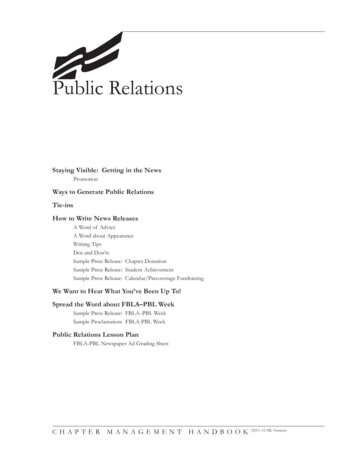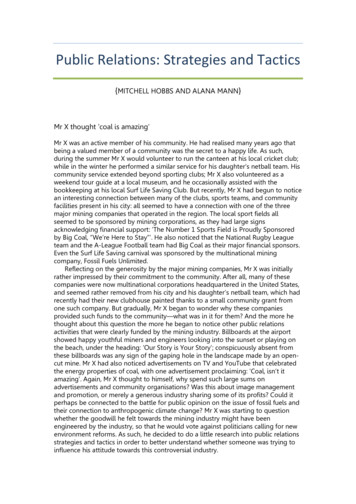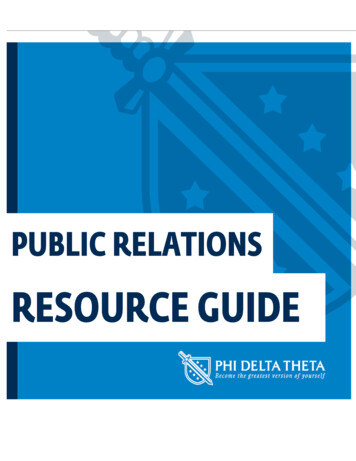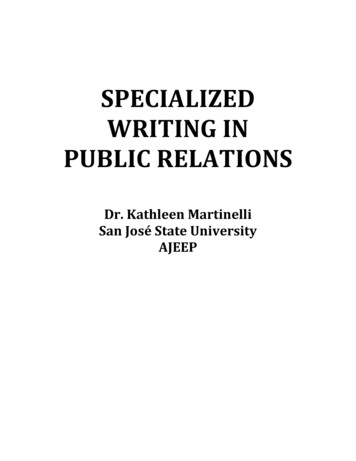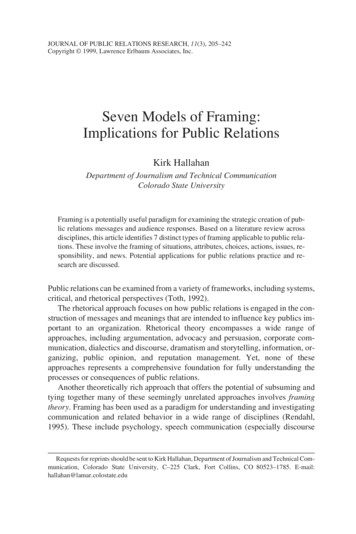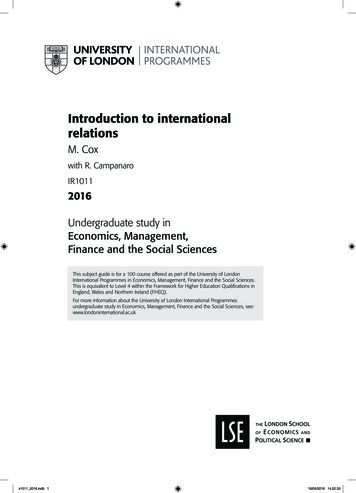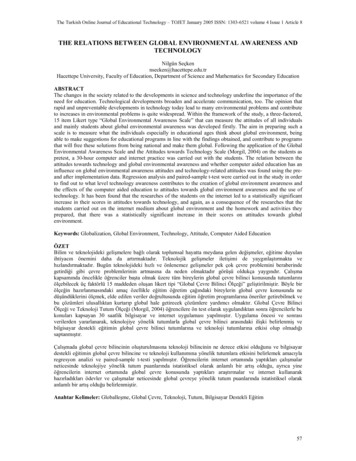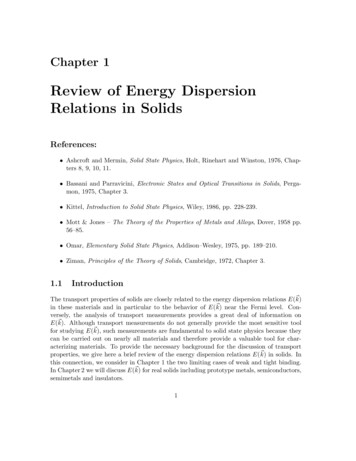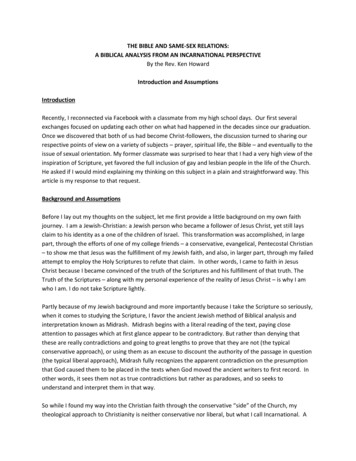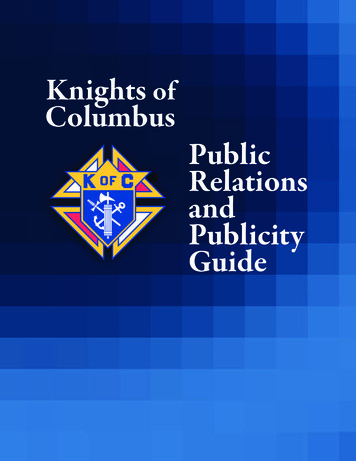
Transcription
Knights ofColumbusPublicRelationsandPublicityGuide
Table of ContentsIntroduction .1Public Relations and Publicity Versus Advertising .1How To Recognize a News Story .2Print, Broadcast and Web-based/Social Media .3Web-based/Social Media .3Print Media .4Broadcast Media .5The Mechanics of Public Relations and Publicity .5Defining Target Markets .5Distribution .5Timing .6Developing and Maintaining Media Lists .6Establishing Media Relations .7Capturing the Media’s Attention .7The News Peg .7Guidelines .8Media Materials Guidelines .8Photo Guidelines .8Feature Stories Guidelines .9Public Service Announcement Guidelines .9Columbia Guidelines .10-11Privacy Guidelines .11Council Website and Monthly Council Newsletter .12-13Advertisements .13Fund Raising for People With Intellectual Disabilities .13Campaign for People With Intellectual Disabilities .14Other Public Relations and Publicity Possibilities .14Rules Governing the use of the Name and Emblem .15-17Copyright Laws .17Appendix .18Press Release Guidelines .18Sample Press Releases .18-21Media Alert Guidelines .22Sample Media Alert .22Sample Public Service Announcement .22Sample Photo Caption .23Sample Photo Permission Release .24-25Tips for Better Photos .26Guidelines for a Knights of Columbus Location Photo Shoot .27Media Contacts .29
IntroductionSometimes it seems that the outstanding work we do as Knights for our Church andcommunity is our best-kept secret. That’s unfortunate, because these works would attractqualified men to join our Order and increase our ability to do good for others.Public relations can be a very useful communications tool in letting people know what theKnights of Columbus is about and the good works that our members do. This guide offersthe “tools of the trade” needed to carry out a successful public relations program.Please note: None of the information included in this guide should be understood as bindinglegal advice. The information contained in this publication is offered to our members asgeneral guidance only. Members are advised to consult a qualified local attorney for definitivelegal advice.Public Relations and Publicity Versus AdvertisingBoth advertising and public relations depend heavily on the media to convey a specific messageto key audiences. However, while advertising may be expensive, public relations press releaseefforts are free.Unlike advertising, public relations cannot guarantee control of where, when and evenif coverage will occur. That is the media’s final decision. However, when successful,public relations can create a major impact, since the media present the desired message oneditorial pages and news broadcasts as opposed to paid advertising space and broadcast time.This is called a “third-party endorsement,” and it is very valuable to the credibility of anorganization and its message.1
How to Recognize a News StoryInformation sent to news sources must describe local, timely, newsworthy events that willappeal to a broad audience.The following is a sample list of council activities that may interest the media. Do not feellimited by the items in this list, as there are bound to be other activities unique to your counciland community that would interest the local media.r Charitable activities such as Coats for Kids distributions, Food for Families collections,support for Special Olympics or Habitat for Humanity, wheelchair deliveries or anyother program that helps people in needr Awards presented to members or to the council, and awards the council presentsto othersr Number of new members recruited during a membership driver New officersr Basketball Free-Throw Championship, “Keep Christ in Christmas” art contest,Substance Abuse Awareness Poster Contest, and Soccer Challenger Senior citizens programsr Refund Support Vocations Program (RSVP)r Fundraising projects for people with intellectual and/or physical disabilitiesr Sponsored cardiopulmonary resuscitation (CPR) courses, blood drives or otherhealth-related coursesr Unusual or extensive church renovationsr Student loan programs, scholarship winnersr Other community service or fundraising projectsr Hands-on assistance to families that have suffered personal disaster, loss or illnessr Support for members of the military and their familiesr Council awards presented to “Family of the Year” and “Knight of the Year”r Local results of Annual Survey of Fraternal Activityr Financial contributions to community agenciesr Major anniversaries or related activitiesr Almost anything that is superlative: biggest, smallest, latest, newest, oldest2
Tips for Better Photographs #1Show Branding and Identify the EventThis photo has much less K of C/council branding on theknight’s shirt and in the background, leaving it unclearwhat organization he is representing or what the eventis about.This better photo shows clear signage and branding on thebackground banner, identifying what the event is and thatit’s a Knights of Columbus-sponsored event.Print, Broadcast and Web-based/Social MediaMedia outlets fall into three major groups: web-based/social media, print and broadcast.All should be used to prudently and effectively target information about your local activitiesin a manner that advances the goals and Catholic identity of the Knights of Columbus.Web-based/Social MediaWeb-based or “Social Media” includes, but is not limited to, mobile communications such astext messaging, the internet, and networking apps and websites.Examples include: social networking sites such as Facebook, Google , Pinterest and LinkedIn;video- and photo-sharing sites such as Flickr, Instagram and YouTube; microblogging sitessuch as Twitter and Tumblr; discussion boards such as Yahoo!; online encyclopedias such asWikipedia; as well as all websites and/or platforms that allow users to publish user-generatedcontent.According to the U.S. Conference of Catholic Bishops, “social media can be powerful toolsfor strengthening community, although social media interaction should not be viewed as asubstitute for face-to-face gatherings. Social media can support communities in a myriad ofways: connecting people with similar interests, sharing information about in-person events,providing ways for people to engage in dialogue, etc.”3
To that end, we encourage our members to employ social media tools in a prudent andeffective manner that advances the goals and Catholic identity of the Knights of Columbus.Please consult the Member Social Communication Policy brief located on the Officers’ DeskReference, under the “social communications” tab. This tool provides accessible guidelines tocouncils, assemblies and members about how to properly employ social media tools to advancethe mission of the Knights of Columbus.All members who use the name and emblem of the Knights of Columbus on social media arerequired to comply with all the instructions listed in the Member Social CommunicationPolicy brief and must exercise common sense.Print Mediar Newspapers include daily, weekly and community papers, as well as secular, diocesan,ethnic and state council publications. These publications often have websites associatedwith them.r Magazines include state and community publications, company and associationpublications, and general and special-interest magazines, such as sports or youthpublications and Columbia magazine.r Newsletters include council, church and organization (senior citizen, chamber ofcommerce, local service clubs) bulletins, and library and school publications.4
Broadcast Mediar Radio includes AM, FM and online stations with news, talk segments or shows.r Broadcast television includes network, independent and local television stations(and their websites).r Cable television includes cable stations with local-origination programming available.Not all local cable companies have local programming capabilities, so check your televisionlistings or call the local cable operator to find out which stations have local programming.The Mechanics of Public Relations and PublicityDefining Target MarketsReaching the right people with the right message is critical to a successful public relations/publicityprogram. First, look at the subject of your message. As you develop your media list (see section titled“Developing and Maintaining Media Lists” for details), you can match your target audience to anappropriate media outlet. The media can tell you who their audiences are.DistributionDistributing news and feature releases can be done in several ways:Hand-DeliveredThis is an effective personal touch and will help to foster a good relationship with key media contacts.EmailMost editors and reporters have distinct personal preferences on how they receive news releases.A reporter may have an email address, but strongly prefer to get a time-sensitive release via fax oranother “paper” form.Mail DistributionIf you mail your news releases, send them first class and address them by name to a specific contact.Call the media outlet for the name of the individual to whom your release should be directed.5
Public Relationsand PublicityElectronic/Web Site DistributionThere are professional services that specialize in distributing news releases directly to medianewsrooms via electronic wire or the internet. If you have any activity that is particularly timely orimportant, and has interest beyond your local community, this vehicle can be useful. These servicescan also be useful in electronically tracking the release after it has been published to a publicationor posted to a media website.TimingYour council should use publicity for two main purposes: (1) to announce forthcoming events inorder to ensure full participation by members and the public, and (2) to inform members and thepublic about the accomplishments of the council and the Order.Proper timing of your release can make the difference in getting media coverage. Know what thedeadlines for each publication are.You should schedule your release about an upcoming event so that the media has it in hand at leasttwo weeks prior to the event or activity. After getting the name of the right editor to contact,follow up with phone calls closer to the time of the event.For releases that pertain to new members or officers, or the results of fundraising or other activities,plan to get the release to the media as quickly as possible and no later than two days after the eventor activity.Developing and Maintaining Media ListsA key component in any public relations effort is an up-to-date and accurate media list. To developthis list, consult Google or other Internet search engines for a listing of all newspapers; magazines;and radio, television and cable stations. Also include church and state council bulletins and diocesannewspapers on your list.For newspapers and their websites, the right contact is usually the city editor or religion editor.For television, radio and cable stations, the news or assignment editor/director is the proper contactperson. Public service announcements should be sent to the public service director.6
Establishing Media RelationsAfter you develop your media list, the next step is to get personally acquainted with your contacts.Keep conversations short and to the point.Always remember these guidelines when contacting a member of the media: Identify yourself, your organization and the purpose of your call (to introduce yourself and yourrole as public relations representative for your Knights of Columbus council). Editors and broadcasters work on deadlines, so always ask if the timing of your call is convenientor when it would be best to call back. Always be appreciative of the time you are given. Once you have established a basic relationship,continue to touch base with your contact from time to time. Don’t become a bother, as editors andbroadcasters are busy. Remember that your story is competing with many others for limited space and you will not alwayssucceed in attracting coverage. Send a note thanking contacts for the help they have given your council.Capturing the Media’s AttentionThe News PegIt is important that your media reports and broadcasts focus on the aspect of the program or eventthat would be interesting to the media and the public. This is called the “news peg.”The following initiatives have the potential of becoming good news pegs:r Charitable activities that benefit the communityr Election of new officersr Knights of Columbus sponsored essay or poster contest winners on local, district,state council or international levelsr Dollars raised for the community through fundraising efforts with examples of wherethe money goes and how it is being usedr Programs for senior citizensr Oldest or youngest Knight’s involvementr Community service projects, especially those that are unique, or involve a large numberof volunteers or volunteer hoursr Results of the Annual Survey of Fraternal ActivityThese would not only make good news stories, but also offer excellent photo and featureopportunities. If you take the photo, be sure it is of professional quality — a sharp, clearimage with good contrast and interesting subject.7
GuidelinesMedia Materials GuidelinesWritten media materials that require the least amount of effort on the part of the editor have the bestchance of publication. When sending any written materials (including press releases, photo releasesand media alerts) to an editor or broadcaster, there are certain guidelines which you must adhere to.r Remember that the appearance of any news release or other correspondence reflectsthe professionalism of the Knights of Columbus and yourself.r Keep information as brief and concise as possible.r Make sure names, numbers, quotations and other factual information are correct.r Obtain written usage consent from every person who appears in a photograph,provides a quote, etc.r Follow up by phone to make sure your release was received.Tips for Better Photographs #2Exposure and CroppingDark exposure and poor cropping (men cut off on both theleft and right) are shown here.Better exposure, as well as good cropping, in a closer actionshot.Photo Guidelines(See Appendix for sample photo release form, photo caption and “Tips For Better Photos.”)Taking and submitting photos Make sure the background is simple and uncluttered. Images should be of people who appear neat and comfortable, rather than posed. Always try toinclude some Knights of Columbus identification (lapel pins, council banners, jackets and T-shirts,caps, etc) and get action into your photograph. Take photographs that tell the story of what’s happening. Avoid so-called “grip and grin” shots(i.e., a photo of a Knight shaking hands while handing over a check to a local hospital administrator),and instead depict Knights actively involved in the Church, Order or community (a photodepicting a patient using Knights of Columbus-donated equipment, etc.).8
Always provide photo captions, identifying the people from left to right. Double-check all namesand titles. Email digital photo files of at least 300 dpi at 4” x 6” or 5” x 7.” JPG format is the most familiar anduniversal file type.Feature Stories GuidelinesUnlike “hard news” stories, which typically focus on concrete data (names, numbers, specific events,etc.), feature stories tend to concentrate on the “human interest” of personalities and personalrelationships.A feature is typically offered as an “exclusive.” This means that you offer it to only onemedia outlet at a time (as opposed to press releases, photo releases and public serviceannouncements, which should be sent to multiple media outlets simultaneously).If the first outlet declines, then you may offer it to another, and so on.To interest the media in writing or producing a feature story on your event: Write a short synopsis of the idea, and call a specific media outlet to discuss it. Send the editor a letter with your synopsis.Public Service Announcement Guidelines(See Appendix for sample public service announcement.)Use public service announcements (PSAs) to announce a Knights of Columbuscommunity activity that is open or available to the public, or to provide information of useto the community (e.g., a message on youth safety). Fundraising activities for the needy,special community projects and special events would all be appropriate subjects for a PSA.Radio PSA Contact the public service director at the sta
Public Relations and Publicity Versus Advertising Both advertising and public relations depend heavily on the media to convey a specific message to key audiences. However, while advertising may be expensive, public relations press release efforts are free. Unlike advertising, public r
